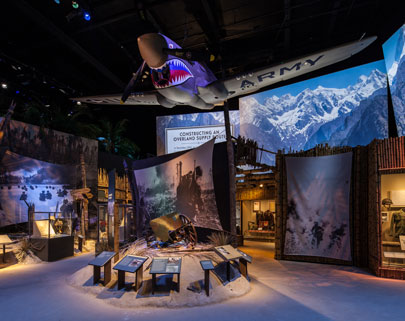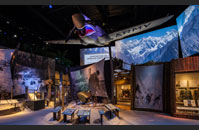CHINA-BURMA-INDIA: THE PACIFIC WAR'S SECOND FRONT
- Road to Tokyo
- The Road to Tokyo: Facing the Rising Sun
- Briefing Room: Japanese Onslaught
- The New Naval Warfare: First Blood
- Guadalcanal: Green Hell
- Pacific Theater Challenges: Fighting in the Tropics
- Island Hopping: Footholds across the Pacific
- China-Burma-India: The Pacific War’s Second Front
- Philippines: Returning to the Philippines
- Death at Japan’s Doorstep: First Assault onto Japanese Soil
- Downfall: Endgame Against Japan

![]()
A restored P-40 Warhawk fighter plane is suspended in front of a massive three-panel video screen, which alternates between an animated map showing wartime supply routes to China and environmental video of the Himalayas, giving an instant impression of the dramatic obstacles and feats of daring that defined the “CBI” theater. By forcing the Japanese to fight on a second front in the Asia-Pacific war, CBI held critical strategic importance: While 11 Japanese army divisions battled US forces on the islands and at sea, a staggering 40 more (nearly one million Japanese) were tied up in the Sino-Japanese War in China—and the Allies were determined to keep them there. Doing so meant supplying the Chinese with essential materiel over enormous distances and confronting a maze of logistical challenges, from the jagged peaks of the Himalayas obstructing air lanes above to strangled roadways below. A contoured topographical map helps illustrate the formidable geographical obstacles American troops faced as they defended supply lines, rescued downed pilots, and engaged in covert operations with the Sino-American Cooperative Organization and the Office of Strategic Services (OSS)—the predecessor to today’s CIA.
Made possible through a gift from Joy & Boysie Bollinger
Additional support by Madlyn and Paul Hilliard and the Irene W. & C.B. Pennington Foundation (restoration of P-40 Warhawk)
![]()




